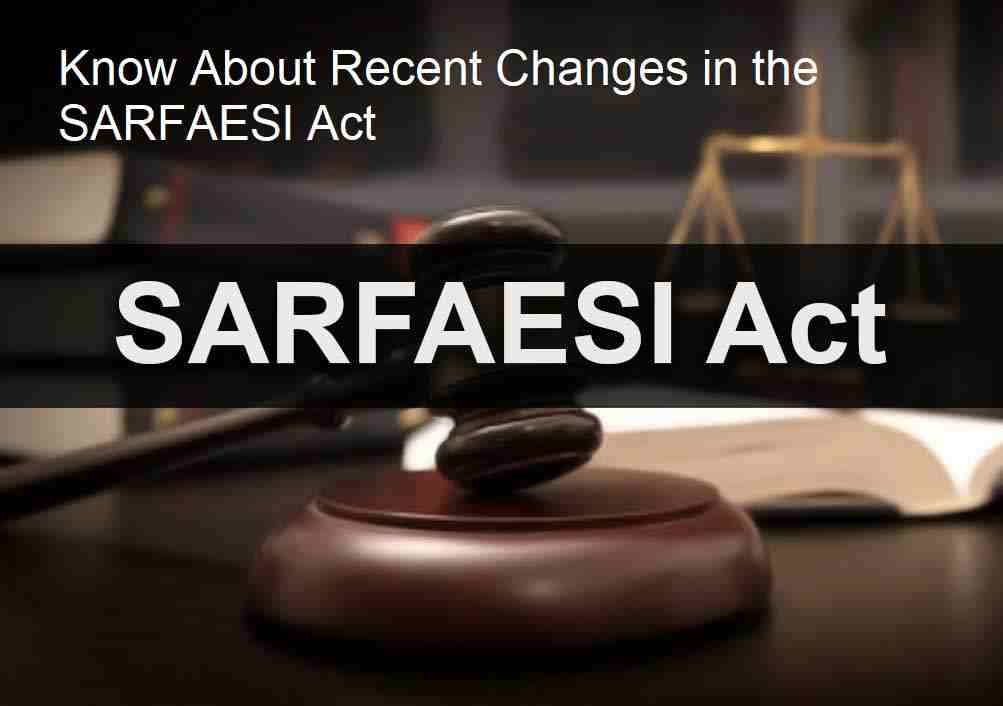Introduction of SARFAESI Act, 2002
The monetary region performs a pivotal function within the dynamic panorama of India's monetary boom. However, the prison framework governing industrial transactions struggled to maintain tempo with evolving practices and economic region reforms, impeding the recovery of defaulting loans and most importantly a growth in non-performing assets (NPAs) of banks and monetary institutions. Committees which include Narasimham I and II, along with the Andhyarujina Committee, had been established with the aid of the valuable authorities to evaluate banking quarter reforms and advocate necessary adjustments to the prison system.
authorizes banks and other financial organizations to auction commercial or residential properties for repaying loans when borrowers fail to repay them.
What is the SARFAESI Act, of 2002?
The SARFAESI Act, short for "Securitization and Reconstruction of Financial Assets and Enforcement of Security Interest Act," authorizes banks and other financial organizations to auction commercial or residential properties for repaying loans when borrowers fail to repay them.
By doing so, the SARFAESI Act aids in reducing Non-appearing property (NPAs) through powerful restoration strategies and reconstruction.
Applicability of SARFAESI Act, 2002
The SARFAESI Act is relevant in cases of secured loans, permitting banks to put underlying securities like hypothecation, mortgage, and pledge in force. Court intervention is unnecessary unless the security is invalid or fraudulent. Unsecured assets, however, require the bank to file a civil case against defaulters in court. The Act does not apply to security interests in agricultural lands, loans less than one lakh rupees, and cases where 80% of the loan has been repaid by the borrower.
Objectives of SARFAESI Act, 2002
The SARFAESI Act has primary targets:
Allows banks and different economic institutions to publicly sell off business or residential homes to get better debt while a borrower fails to pay off the loan amount.
- Efficient and fast restoration of non-appearing belongings (NPAs) of banks and monetary institutions.
- Empowering banks and financial institutions to auction residences, each commercial and home, in cases of borrower default.
How SARFAESI Act, of 2002 work?
The SARFAESI Act offers banks and monetary institutions the authority to capture the belongings of defaulting borrowers without courtroom involvement, except for agricultural land. If a borrower defaults on loan reimbursement, the monetary group can classify the account as a Non-performing Asset (NPA) and difficulty notices to the defaulting borrower. The borrower has 60 days to discharge their liabilities. If the borrower fails to conform, the bank has the subsequent alternatives
- Take possession of the loan security.
- The right to the security can be leased, sold, or assigned.
- Manage the security or appoint someone else to manage it.
- The Act also facilitates the establishment of Asset Reconstruction Companies (ARCs), regulated by the Reserve Bank of India (RBI), to acquire assets from banks and other financial institutions.
Formation of SARFAESI Act, 2002
The SARFAESI Act was formulated to alter the securitization and reconstruction of economic property, put into effect protection interests, and address related topics. It applies throughout India and has gone through amendments through the Enforcement of Safety Interest and Restoration of Debts Legal Guidelines (modification) Act, 2016.
Amendments to the SARFAESI Act, 2002
The 2016 amendment to the SARFAESI Act introduced numerous changes, together with:
- Empowering banks and Asset Reconstruction agencies (ARCs) to switch a part of the debt of defaulting groups into fairness.
- Granting banks the ability to request immovable properties set for public sale if no bids are obtained, letting them alter the debt with the quantity paid for the belongings.
- Provide the choice for banks to sell the property to a new customer, who can remit the debts through the years.
Rights of Borrower under SARFAESI Act, 2002
Borrowers under the SARFAESI Act have specific rights:
- They can remit dues to avoid losing their securities before the sale concludes.
- They are entitled to compensation for defaults by authorized officers.
- Section 17 of the SARFAESI Act allows borrowers to approach the Debt Recovery Tribunal to address grievances against creditors or authorized officers.
Methods of Recovery under SARFAESI Act, 2002
The SARFAESI Act outlines three methods for recovering Non-Performing Assets (NPAs):
- Securitization: The process of issuing marketable securities backed by using a pool of current assets, which can be bought after conversion right into a marketable security.
- Asset Reconstruction: Empowers Asset Reconstruction groups to control the borrower's commercial enterprise, sell or accumulate it, or reschedule debt bills as consistent with the Act.
- Enforcement of protection without court Interruption: allows banks and financial establishments to issue notices for payment to people who received secured belongings from the borrower.
Assets Not Covered Under SARFAESI Act, 2002
Certain assets are not covered by the SARFAESI Act, including:
- positive properties aren't blanketed by using the SARFAESI Act, inclusive of:
- cash or protection is given following the Sale of Goods Act of 1930 or the Indian Contract Act of 1872.
- rentals, hire-buy, conditional sale, or other contracts without created protection interest.
- Unpaid sellers' rights under segment 47 of the Sale of Products Act of 1930.
- residences aren't liable for sale or attachment below phase 60 of the Code of Civil Technique, 1908.
THE SECURITISATION AND RECONSTRUCTION OF FINANCIAL ASSETS AND ENFORCEMENT OF SECURITY INTEREST ACT, 2002: Click Here Pdf, Hindi Pdf
Conclusion
The SARFAESI Act, of 2002, stands as a crucial piece of legislation facilitating the efficient recovery of non-performing assets and empowering banks and financial institutions to take necessary actions without prolonged court procedures.
Through a systematic approach, the Act aims to strike a balance between the rights of creditors and borrowers while contributing to the overall health and stability of the financial sector in India.
The Sarfaesi Act, 2002 - Latest Amendments with PDF
The act can be accessed below:
| Section |
Content |
Details |
| 1 |
Short title, extent and commencement |
Click here |
| 2 |
SARFAESI Act delineates key terms like "banking company," "borrower," "default," "financial asset," "secured creditor," and "security interest," forming the core of the Act and aiding comprehension of its provisions.
|
Click here |
| 3 |
Registration of asset reconstruction companies, taking possession of and selling the secured assets. |
Click here |
| 4 |
Cancellation of certificate of registration. |
Click here |
| 5 |
Acquisition of rights or interest in financial assets. |
Click here |
| 5A |
Transfer of pending applications to any one of the Debts Recovery Tribunals in certain cases. |
Click here |
| 6 |
Notice to obligor and discharge of obligation of such obligor. |
Click here |
| 7 |
Issue of security by raising receipts or funds by an asset reconstruction company. |
Click here |
| 8 |
Exemption from registration of security receipt. |
Click here |
| 9 |
Measures for asset reconstruction. |
Click here |
| 10 |
Other functions of the asset reconstruction company. |
Click here |
| 11 |
Resolution of disputes. |
Click here |
| 12 |
Power of Reserve Bank to determine policy and issue directions. |
Click here |
| 12A |
Power of Reserve Bank to call for statements and information. |
Click here |
| 12B |
Power of Reserve Bank to carry out audit and inspection. |
Click here |
| 13 |
Enforcement of security interest. |
Click here |
| 14 |
Chief Metropolitan Magistrate or District Magistrate to assist the secured creditor in taking possession of the secured asset. |
Click here |
| 15 |
Manner and effect of take over of management. |
Click here |
| 16 |
No compensation to directors for loss of office. |
Click here |
| 17 |
Application against measures to recover secured debts. |
Click here |
| 17A |
Making of application to Court of District Judges in certain cases. |
Click here |
| 18 |
Appeal to Appellate Tribunal. |
Click here |
| 18A |
Validation of fees levied. |
Click here |
| 18B |
Appeal to the High Court in certain cases. |
Click here |
| 18C |
Right to lodge a caveat. |
Click here |
| 19 |
Right of the borrower to receive compensation and costs in certain cases. |
Click here |
| 20 |
Central Registry. |
Click here |
| 20A |
Integration of registration systems with Central Registry. |
Click here |
| 20B |
Delegation of powers. |
Click here |
| 21 |
Central Registrar. |
Click here |
| 22 |
Register of securitization, reconstruction, and security interest transactions. |
Click here |
| 23 |
Filing of transactions of securitization, reconstruction, and creation of security interest. |
Click here |
| 24 |
Modification of security interest registered under this Act. |
Click here |
| 25 |
Asset reconstruction company or secured creditors to report satisfaction of security interest. |
Click here |
| 26 |
Right to inspect particulars of securitization, reconstruction, and security interest transactions. |
Click here |
| 26A |
Rectification by Central Government in Matters of registration, modification satisfaction, etc. |
Click here |
| 26B |
Registration by secured creditors and other creditors. |
Click here |
| 26C |
Effect of the registration of transactions, etc. |
Click here |
| 26D |
Right of enforcement of securities. |
Click here |
| 26E |
Priority to secured creditors. |
Click here |
| 27 |
Penalties. |
Click here |
| 28 |
[Omitted.] |
Click here |
| 29 |
Offences. |
Click here |
| 30 |
Cognizance of offence. |
Click |
| 30A |
Power of the adjudicating authority to impose a penalty. |
Click here |
| 30B |
Appeal against penalties. |
Click here |
| 30C |
Appellate Authority. |
Click here |
| 30D |
Recovery of penalties. |
Click here |
| 31 |
Provisions of this Act not to apply in certain cases. |
Click here |
| 31A |
Power to exempt a class or classes of banks or financial institutions. |
Click here |
| 32 |
Protection of action taken in good faith. |
Click here |
| 33 |
Offences by companies. |
Click here |
| 34 |
Civil court not to have jurisdiction. |
Click here |
| 35 |
The provisions of this Act to override other laws. |
Click here |
| 36 |
Limitation. |
Click here |
| 37 |
Application of other laws not barred. |
Click here |
| 38 |
Power of Central Government to make rules. |
Click here |
| 39 |
Certain provisions of this Act apply after the Central Registry is set up or caused to be set up. |
Click here |
| 40 |
Power to remove difficulties. |
Click here |
| 41 |
Amendments to certain enactments. |
Click here |
| 42 |
Repeal and save. |
Click here |



